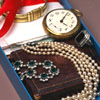- sale
- new items
- lovely beads
- wedding beads
- beads for teens
- for custom order
- newsletter
- recognition
- testimonials
- birthstones
- zodiac signs
- jewelry guide
SHOP BAG
![]() in your bag 0 items
in your bag 0 items

Jewelry which is termed "estate" or "vintage" includes many decades or eras, that include Georgian, Early Victorian, Mid-Victorian, Late Victorian, Arts and Crafts era, Art Nouveau, Edwardian, Art Deco and Retro. Vintage jewelry can range from inexpensive to highly costly, but the act of collecting such jewelry is enjoyable for enthusiasts.
Georgian jewelry (1714-1837)
Georgian era jewelry is handmade, making the quality of each piece variable. Needless to say, Georgian jewelry is very rare. Often featuring nature-inspired designs such as leaves and birds, Georgian jewelry frequently includes precious stones.
Early Victorian, romantic jewelry (1837-1850)
Like jewelry of the Georgian era, early Victorian era jewelry features nature-inspired designs. Frequently, these designs would be delicately and intricately etched into gold. Lockets and brooches were popular everyday jewelry during the early Victorian era whereas colored gemstones and diamonds were worn during the evening.
Mid-Victorian, grand jewelry (1860-1880)
Because the Grand or Mid-Victorian era corresponded with the Victoria's husband, many jewelry pieces have solemn, grave designs. Known as mourning jewelry, the pieces feature heavy, dark stones. Jet, onyx, amethyst, and garnet are frequently found in jewelry from this period. The jewelry also became especially creative during this period. More colorful designs were born featuring shells, mosaics and colorful gemstones.
Late Victorian, aesthetic jewelry (1885-1900)
During the Late Victorian or Aesthetic period, jewelers used diamonds and feminine, bright gemstones such as sapphire, peridot, and spinel. Star and crescent designs as well as elaborate hat pins were also popular.
Arts and crafts jewelry (1894-1923)
Due to the Industrial Revolution, many jewelry designers rebelled during the Arts and Crafts movement, returning to intricate jewelry designs and handmade craftsmanship. It was common for jewelry of this era to be simple in pattern, made of colorful, uncut stones.
Art Nouveau jewelry (1895-1915)
Designed by Rene Jules Lalique in France and other jewelers in America, Art Nouveau jewelry features natural designs such as flowers and butterflies.
Edwardian jewelry (1901-1910)
The Edwardian period was born when Queen Victoria died and her son Edward became king. During this period, expensive gemstones such as diamonds, emeralds and rubies and elaborate designs were the fashion.
Art Deco jewelry (1920-1935)
Influenced by African, Egyptian and Japanese themes, Art Deco jewelry is famous for its geometric designs, sharp lines, and bright colors. Bakelite, celluloid, enamel and doublets were used frequently during this era. Necklaces were long and bracelets were worn many at a time. Amber and murano beads were worn as well as chokers.
Retro jewelry (1940s)
Inspired by Hollywood, Retro jewelry is colorful, bold and elaborate. Commonly worn were large cocktail rings, bracelets, watches, necklaces and charm bracelets.

